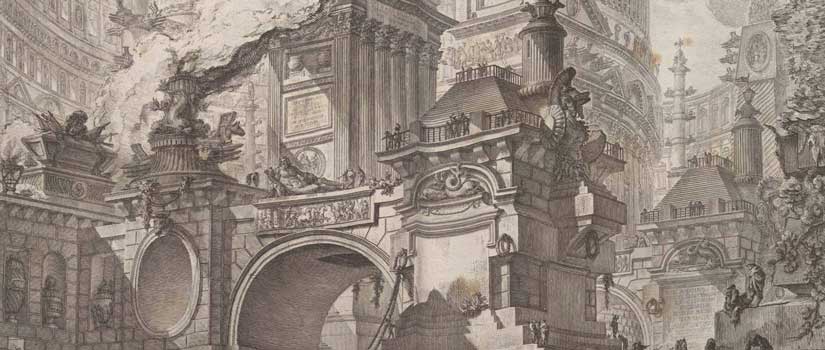The incredibly detailed work and vivid imagination of 18th-century Italian archaeologist, architect and artist Giovanni Piranesi (1720-1778) are now on display at the University of South Carolina Ernest F. Hollings Special Collections Library.
The exhibit includes maps and architectural illustrations from Piranesi’s Opere, a 29-volume set of his etchings, along with ancient artifacts on loan from the Columbia Museum of Art, historical ephemera and related works of architecture, cartography and literature.
Published in the 1830s after his death, the Opere, or Works, assembled all of Piranesi’s individual publications, including more than 1,000 images printed from the original engraved copper plates.
Famous for his etchings of Roman ruins and fictitious prisons, Piranesi created accounts of ancient buildings, monuments and street views in remarkable detail. His work includes elaborate designs of architectural elements, vases, altars, tombs, and people engaged in activities of daily life.
University Libraries Irvin Department of Rare Books and Special Collections is one of fewer than 10 institutions in the world that holds a complete set of Piranesi's Opere.
“Piranesi is inviting but also challenging. The pictures are so beautiful, but also inaccessible and difficult to navigate in ways that I think he was very well aware of,” says Jeanne Britton, curator at the Irvin Department of Rare Books and Special Collections. “I think he wanted to challenge his viewers, but one of the consequences is that his works aren’t as studied as they deserve to be.”
Britton is also leading a project funded by the National Endowment for the Humanities, The Digital Piranesi, to make the materials accessible in an enhanced, interactive online collection and to make them visible, legible and searchable in ways that the original works are not.
“His work isn’t just a set of illustrations, it is an interface. Piranesi didn’t just want to give us beautiful images, he wanted to guide us through them,” Britton says. “Through the digital collection, we can be creative with Piranesi’s images but in ways that are authentic to his vision.”
NEH postdoctoral fellow Zoe Langer has been working on the project for the past year.
“Translating Piranesi’s prints — visually through digital tools and linguistically into English — has given us insight into his words, images, methods, intellectual approach and 18th-century Italian culture.”
While the Hollings Library is currently operating on a modified schedule due to COVID-19,
the curators are offering in-person tours by request at digitalpiranesi@gmail.com. The exhibit, on display through October 2021, will be open to the public during
regular business hours as soon public safety can be ensured.
